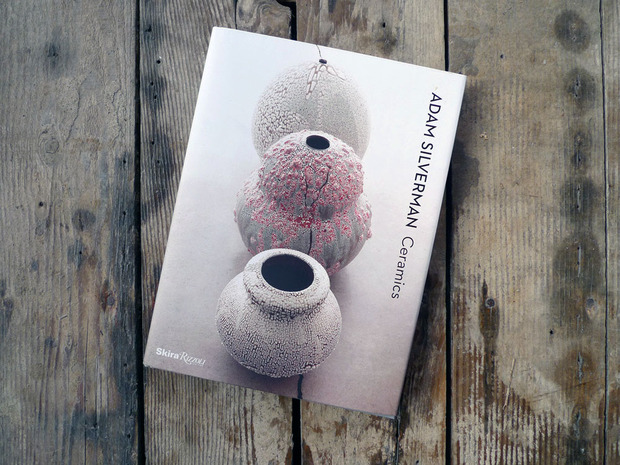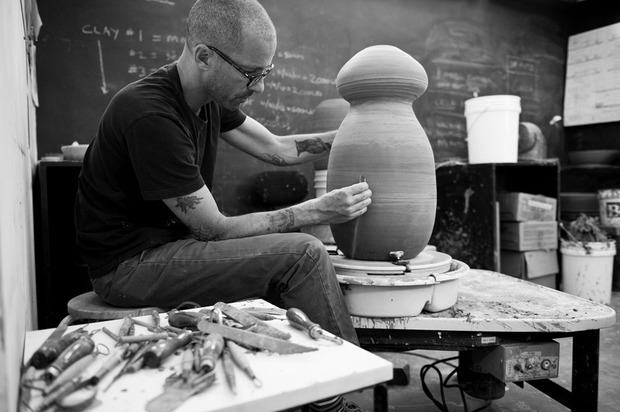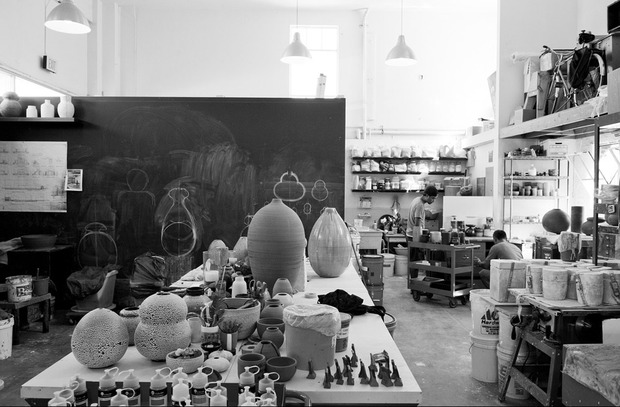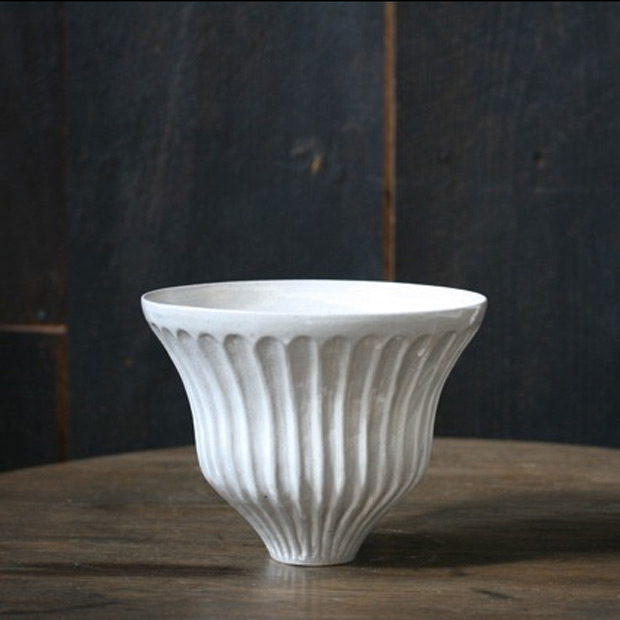Adam Silverman Ceramics
The LA-based potter’s new book explores the tactile world of his creations


Adam Silverman’s affinity for texture translates to his self-titled book about ceramic art. It’s a book that achieves its goal of being an object rather than a merely a catalogue of work. Many of the glossy pages showcase single ceramic pieces dramatically captured by photographer Stefano Massei; the detail in each photograph offering the next best thing to physically seeing Silverman’s creations in person. For the book’s next section Katrina Dickson takes over with a series of black and white images that capture Silverman himself at work in his studio. In the final section of the book, famed artist Shephard Fairey offers his interpretation of Silverman’s work, followed by an in-depth interview and essays from the art world.
The physical act of turning the pages of “Adam Silverman Ceramics” becomes a meditation on form, texture, color and landscape. The experience of seeing Silverman’s work in person or in his new book, published by the famed Rizzoli New York, offers the reader discoveries that are subtle or dramatic.
At his studio inside Heath Ceramics in Los Angeles, Silverman took a break from planning several upcoming shows and events around the US and in Japan to talk about the process of making the book.

How do you translate the scale of ceramics to photography and the flat page in a way which still tells the story of your work?
That is, of course, the challenge. The goal for me was to make a book that was as rich as one of the pots, as its own object. It started with putting together a team of people who were sympathetic to the work and who knew the work. The designer is Japanese and a collector of ceramics and furniture. Getting designer Tamotsu Yagi on board was the first move. We were talking about what we wanted the book to be—I wanted it to be an object that stands on its own as a beautiful thing, not just a document of pictures of pots.
How did you decide to structure the book?
First we hired photographers to shoot images for the book, so there would be all new photography. The idea was for there to be two sections—one of the objects and one of the studio. There would be two different photographers, two different papers—color and black and white—so that they were really distinct sections in the book. Stefano Massei does not work in galleries shooting pictures of art. He takes pictures of objects. If you look on his website, there are pictures of old tools. He has obsessively photographed—almost erotically—a rusty old pitchfork; that is his art as a photographer. He is the only person who worked on the book that I did not know before.

Did you need to borrow from collectors in order to photograph all of the pieces in the book?
I borrowed back several. The majority of the work is from two shows last year. One that was at Edward Cella here in Los Angeles and one that was at Tomio Koyama in Kyoto. Stefano Massei came down for a few days and shot all of the stuff going to Japan before we shipped it. He came down again before the Edward Cella show and we shot for four days in the gallery there.
How did you approach the black and white photography for the studio section?
For the black and white photographs, the idea from Katrina Dickson was sort of an anthropological photo essay of the studio. It is her perspective on what the studio feels like, not meant to be a straight chronological document of the process of making a pot. It’s mostly supposed to give you a sense of what it feels like to be there and the process. The paper is a more matte texture. Each section of the book has its own paper. The third section, the text, also has its own paper so that your hand is aware when you are changing sections—not just your eye. It’s a metaphor, a direct link to clay having texture.
Shepard Fairey wrote the book’s introduction. How did that come about?
I have known him forever, almost 20 years. We are part of the same community. We live in the same neighborhood. In the book there are two essays by art world academics. Then there is a conversation with a curator and architect. The idea of the introduction is I wanted it to be written by somebody who is a maker and not from the ceramic world, but somebody who would bring a left-field interpretation. I was thinking about a dancer or someone from fashion or a painter. Shepard is all those, except a dancer. He worked really hard on it, spent a lot of time. The hope would be that he would give a new perspective on the work.

What are you working on now?
After the book comes out on September 24th [2013], I am having my first ever show in San Francisco at Heath in a new space in the new building. It was the old boiler room of a commercial laundry and hasn’t been used for anything but construction. We are going to stage the show in there in an alternative, dramatic, beautiful space, then book release parties in Los Angeles and New York. Then I head to Houston for the Texas Contemporary Art Fair for a small show and a talk. Then I have a Chinati open house in Marfa. The biggest thing is the show at the Laguna Art Museum; it opens the end of October. I have distinct bodies of work with close to one hundred pieces in that show. Then I head to Tokyo in November for two shows.

What do you hope to achieve with the book, and what do you hope people will take from it?
Personally for me—for my career—I hope it opens doors in places where I am not right now. My career is basically California and Japan-based which I am vey happy about, but I would like for the next 10 years to have activity in New York and Europe. So hopefully this will help. I feel like there is a bigger conversation about ceramics and art now. There are some big serious galleries that have been having ceramics shows. David Kordnasky Gallery had a ceramics show up this summer, Blum & Poe had a ceramics show last year. The Ken Price show had a huge catalogue. So I feel if this book can be a little part of the conversation changing the perception of clay, that’s a positive thing.
“Adam Silverman Ceramics” is available from Amazon for $36.
Photos by Stefano Massei and Katrina Dickson












